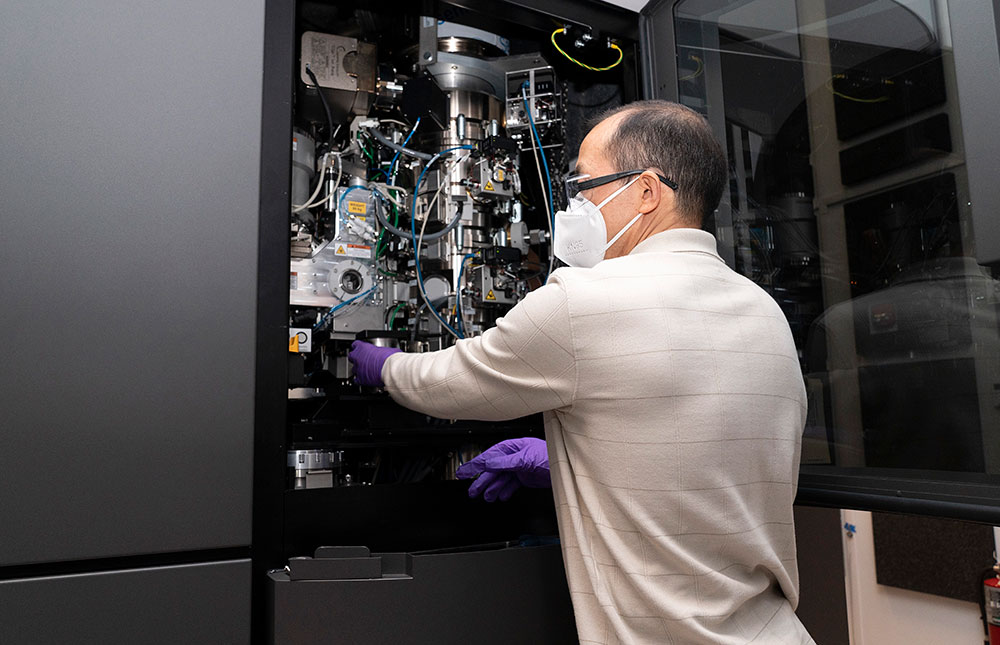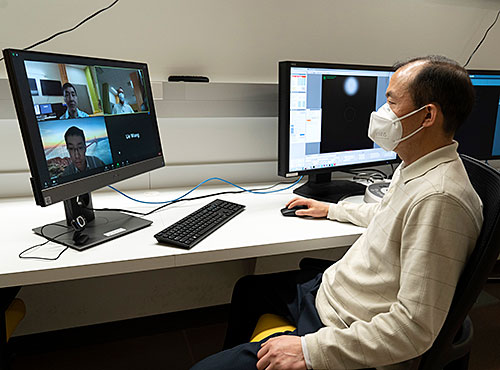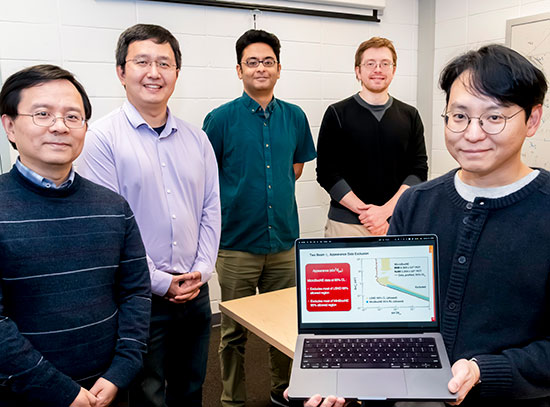Science Begins at Brookhaven Lab's New Cryo-EM Research Facility
Brookhaven Lab's Laboratory for BioMolecular Structure is now open for experiments with visiting researchers using two NY State-funded cryo-electron microscopes
January 14, 2021
 enlarge
enlarge
Brookhaven Lab Scientist Guobin Hu loaded the samples sent from researchers at Baylor College of Medicine into the new cryo-EM at LBMS.
UPTON, NY—On January 8, 2021, the U.S. Department of Energy’s (DOE) Brookhaven National Laboratory welcomed the first virtually visiting researchers to the Laboratory for BioMolecular Structure (LBMS), a new cryo-electron microscopy facility. DOE’s Office of Science funds operations at this new national resource, while funding for the initial construction and instrument costs was provided by NY State. This state-of-the-art research center for life sciences imaging offers researchers access to advanced cryo-electron microscopes (cryo-EM) for studying complex proteins as well as the architecture of cells and tissues.
Many modern advances in biology, medicine, and biotechnology were made possible by researchers learning how biological structures such as proteins, tissues, and cells interact with each other. But to truly reveal their function as well as the role they play in diseases, scientists need to visualize these structures at the atomic level. By creating high-resolution images of biological structure using cryo-EMs, researchers can accelerate advances in many fields including drug discovery, biofuel development, and medical treatments.
This first group of researchers from Baylor College of Medicine used the high-end instruments at LBMS to investigate the structure of solute transporters. These transporters are proteins that help with many biological functions in humans, such as absorbing nutrients in the digestive system or maintaining excitability of neurons in the nervous system. This makes them critical for drug design since they are validated drug targets and many of them also mediate drug uptake or export. By revealing their structure, the researchers gain more understanding for the functions and mechanisms of the transporters, which can improve drug design. The Baylor College researchers gained access to the cryo-EMs at LBMS through a simple proposal process.
“Our experience at LBMS has been excellent. The facility has been very considerate in minimizing user effort in submission of the applications, scheduling of microscope time, and data collection,” said Ming Zhou, Professor in the Department of Biochemistry of Molecular Biology at Baylor College of Medicine.
All researchers from academia and industry can request free access to the LBMS instruments and collaborate with the LBMS’ expert staff.
 enlarge
enlarge
During the measurement of the samples, the LBMS team interacted with the scientists from Baylor College of Medicine through Zoom to coordinate the research.
“By allowing science-driven use of our instruments, we will meet the urgent need to advance the molecular understanding of biological processes, enabling deeper insight for bio-engineering the properties of plants and microbes or for understanding disease,” said Liguo Wang, Scientific Operations Director of the LBMS. “We are very excited to welcome our first visiting researchers for their remote experiment time. The researchers received time at our instruments through a call for general research proposals at the end of August 2020. Since September, we have been running the instruments only for COVID-19-related work and commissioning.”
LBMS has two cryo-electron microscopes—funded by $15 million from NY State’s Empire State Development—and the facility has space for additional microscopes to enhance its capabilities in the future. In recognition of NY State’s partnership on the project and to bring the spirit of New York to the center, each laboratory room is associated with a different iconic New York State landmark, including the Statue of Liberty, the Empire State Building, the Stonewall National Monument, and the Adam Clayton Powell Jr. State Office Building.
“By dedicating our different instruments to New York landmarks, we wanted to acknowledge the role the State played in this new national resource and its own unique identity within Brookhaven Lab,” said Sean McSweeney, LBMS Director. “Brookhaven Lab has a number of facilities offering scientific capabilities to researchers from both industry and academia. In our case, we purposefully built our center next to the National Synchrotron Light Source II, which also serves the life science research community. We hope that this co-location will promote interactions and synergy between scientists for exchanging ideas on improving performance of both facilities.”
Brookhaven’s National Synchrotron Light Source II (NSLS-II) is a DOE Office of Science User Facility and one of the most advanced synchrotron light sources in the world. NSLS-II enables scientists from academia and industry to tackle the most important challenges in quantum materials, energy storage and conversion, condensed matter and materials physics, chemistry, life sciences, and more by offering extremely bright light, ranging from infrared light to x-rays. The vibrant structural biology and bio-imaging community at NSLS-II offers many complementary techniques for studying a wide variety of biological samples.
“At NSLS-II, we build strong partnership with our sister facilities, and we are looking forward to working closely with our colleagues at LBMS. For our users, this partnership will offer them access to expert staff at both facilities as well as to a versatile set of complementary techniques,” said NSLS-II Director John Hill. “NSLS-II has a suite of highly automated x-ray crystallography and solution scattering beamlines as well as imaging beamlines with world-leading spatial resolution. All these beamlines offer comprehensive techniques to further our understanding of biological system. Looking to the future, we expect to combine other x-ray techniques with the cryo-EM data to provide unprecedented information on the structure and dynamics of the engines of life.”
LBMS operations are funded by the U.S. Department of Energy’s Office of Science. NSLS-II is a DOE Office of Science user facility.
Brookhaven National Laboratory is supported by the U.S. Department of Energy’s Office of Science. The Office of Science is the single largest supporter of basic research in the physical sciences in the United States and is working to address some of the most pressing challenges of our time. For more information, visit https://energy.gov/science.
Follow @BrookhavenLab on Twitter or find us on Facebook.
2021-17635 | INT/EXT | Newsroom









